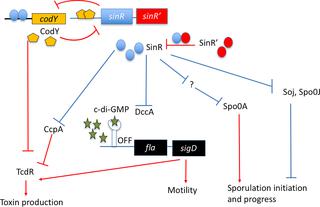PLoS Pathogens ( IF 5.5 ) Pub Date : 2018-03-12 , DOI: 10.1371/journal.ppat.1006940 Brintha Parasumanna Girinathan , Junjun Ou , Bruno Dupuy , Revathi Govind

|
Clostridium difficile is the primary cause of nosocomial diarrhea and pseudomembranous colitis. It produces dormant spores, which serve as an infectious vehicle responsible for transmission of the disease and persistence of the organism in the environment. In Bacillus subtilis, the sin locus coding SinR (113 aa) and SinI (57 aa) is responsible for sporulation inhibition. In B. subtilis, SinR mainly acts as a repressor of its target genes to control sporulation, biofilm formation, and autolysis. SinI is an inhibitor of SinR, so their interaction determines whether SinR can inhibit its target gene expression. The C. difficile genome carries two sinR homologs in the operon that we named sinR and sinR’, coding for SinR (112 aa) and SinR’ (105 aa), respectively. In this study, we constructed and characterized sin locus mutants in two different C. difficile strains R20291 and JIR8094, to decipher the locus’s role in C. difficile physiology. Transcriptome analysis of the sinRR’ mutants revealed their pleiotropic roles in controlling several pathways including sporulation, toxin production, and motility in C. difficile. Through various genetic and biochemical experiments, we have shown that SinR can regulate transcription of key regulators in these pathways, which includes sigD, spo0A, and codY. We have found that SinR’ acts as an antagonist to SinR by blocking its repressor activity. Using a hamster model, we have also demonstrated that the sin locus is needed for successful C. difficile infection. This study reveals the sin locus as a central link that connects the gene regulatory networks of sporulation, toxin production, and motility; three key pathways that are important for C. difficile pathogenesis.
中文翻译:

难辨梭状芽胞杆菌基因位点的多效性作用
艰难梭菌是医院腹泻和假膜性结肠炎的主要原因。它产生休眠的孢子,作为传染媒介,负责疾病的传播和有机体在环境中的持久性。在枯草芽孢杆菌中,编码SinR(113 aa)和SinI(57 aa)的罪基因座负责孢子形成抑制。在B中。枯草杆菌SinR主要充当其靶基因的阻遏物,以控制孢子形成,生物膜形成和自溶。SinI是SinR的抑制剂,因此它们的相互作用决定了SinR是否可以抑制其靶基因表达。该Ç。艰难基因组携带两个sinR我们在操纵子中命名为sinR和sinR'的同系物,分别编码SinR(112 aa)和SinR'(105 aa)。在这项研究中,我们构建并表征了两个不同C中的sin基因突变体。难辨菌株R20291和JIR8094,以解释基因座在C中的作用。艰难的生理学。对sinRR'突变体的转录组分析显示,其在控制C.孢子形成,毒素产生和运动等几种途径中的多效性作用。艰难的。通过各种遗传和生化实验,我们证明SinR可以调节这些途径中的关键调控因子的转录,包括sigD,spo0A和codY。我们发现SinR′通过阻断其阻遏物活性而充当SinR的拮抗剂。使用仓鼠模型,我们还表明,罪是需要成功的轨迹Ç。难感染。这项研究揭示了罪恶基因位点是连接孢子形成,毒素产生和运动的基因调控网络的中心环节。对C而言重要的三个关键途径。艰难的发病机理。











































 京公网安备 11010802027423号
京公网安备 11010802027423号